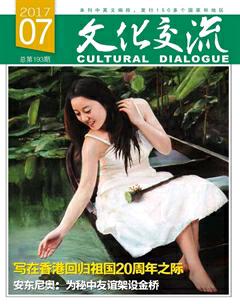《西游記》走紅德國書展
王湛


《西游記》是中國古代四大名著之一,不僅在中國長盛不衰,也是世界文學的瑰寶。最近,瑞士人林小發(Eva Lüdi Kong)憑借其翻譯的《西游記》首個德文全譯本,獲得第十三屆萊比錫書展獎翻譯類大獎。這是德語地區圖書行業重要獎項。書展主辦方在頒獎理由中寫道,作為中國最膾炙人口的文學作品,在此之前,《西游記》沒有以德文的形式出版過,最多也只出版過一個簡略的節譯本。“現在它全部的豐富性和多樣性能得以呈現,這是林小發的功績。”主辦方評價她“不僅僅是把一種語言翻譯成另一種,更在不同時代和不同思維方式的峭壁中搭起了一座橋。這正是‘世界文學的真意,一種來自全世界、面向全世界的文學。”
林小發1968年生于瑞士比爾,曾在中國生活超過25年,2004年畢業于浙江大學人文學院中國古代文學碩士專業,導師是樓含松教授。
翻譯了17年,被認為像《魔戒》
引起更多中國讀者關注的是,譯林出版社的編輯王蕾將德語版《西游記》的開頭部分回譯成現代漢語,發在微博上:“有一首詩說:太初混沌不分/天地晦暗地混淆在一起/萬物模糊,橫無際涯/誰都沒有見過那時的景象……”
中文版《西游記》的原文是“詩曰:混沌未分天地亂,茫茫渺渺無人見。……”
“不小心當了網紅”,王蕾說,微博里的這篇回譯之作,瀏覽量高得不同尋常。很多讀者看回譯,覺得是類似《魔戒》的史詩。
王蕾認為,回譯的《西游記》,有些像《魔戒》作者托爾金的作品《精靈寶鉆》。
學者李天飛也被王蕾的回譯觸動。在他眼中,《西游記》本有市井小說的特征,帶著戲謔。德譯,再回譯,文本帶有了西方文學的壯美和悲劇感。
中國讀者的反應,林小發根本沒料到,“但現在想想當然也不奇怪”。
林小發翻譯這部中國古典名著,足足花了17年。對她來說,漫長翻譯過程中的成長與挫折,恰恰應和了《西游記》的主題——取經。
在自述中,林小發寫道,她在翻譯過程中盡量讀了一些構成明代文人常識的經典,包括四書五經、佛經,還有與《西游記》相關的一些道教經典,如此一邊閱讀一邊調查研究,“翻譯過程也就成為了一個獨特的‘取真經的過程。”
她還到處走訪寺廟、道觀,向大德高僧請教書中一些深層涵義的解釋;大量閱讀18和19世紀的德國文學,從歌德等人的詩歌中感悟修辭技巧。
“與其說犧牲了長達17年的時間,不如說是在不知不覺地挖掘一個莫大的寶藏,一個不朽的精神世界。”林小發寫道,“譯本出版了之后,我從許多讀者的反饋得知,小說在這些方面的寓意得到了有效的傳達,對此我深感欣慰。”
在浙江大學的碩士論文寫的是《西游記》
林小發對中國文化的興趣來得很突然。1983年,中國廣西的一個雜技團訪問比爾,林小發被介紹冊上的中國字迷住,開始自學中文。
有網友激動地認出了她:“這是我讀研究生時的老師呀,瑞士人,當年她是坐著火車哐哧哐哧穿越歐亞大陸來到中國。讀的是中國美院版畫系。特別淳樸,特別不物質,我們經常看她騎著那種后座帶娃的二輪上下班,眼神特別干凈。”
上世紀90年代,林小發來到中國,在中國美院書法系和版畫系學習。偶然的機會,她在上海古籍書店讀到了《西游記》,其中蘊含的中國古代世界觀深深吸引了她。
1999年,讀過原著和兩種德文譯本的林小發自己動手翻譯《西游記》。
翻譯越深入,林小發越察覺自己的不足。她特地去浙江大學學習中國古典文學,碩士論文主題是《西游記》的“正路”思想。
林小發在浙大的導師樓含松說,林小發其實還有一個中文名,叫林觀殊:“她讀研究生的目的也是很強的,就是為了做好《西游記》的翻譯工作。”
因為樓含松寫過《西游記》的研究文章,林小發拜他為師。樓含松回憶,林小發的中文水平很好,完全稱得上是中國通。“我不懂德文,跟她都是漢語交流,我們討論《西游記》多一點。她畢業論文探討《西游記》的主題,碩士論文答辯的時候,老師們對她評價都蠻高的。”
“她終于完成了這項艱巨的工作,真的非常了不起!我為她感到高興和驕傲!”樓含松說。
林小發非常低調,對獲獎之事不愿多說。對于《西游記》又翻回中文一事,遠在瑞士的林小發表示:“若能激起中國人重讀原版興趣的話,我很開心。譯回中文有趣,能讀原著是福!”
在德語國家文壇,《西游記》原來是不存在的
因為不懂德文,樓含松還沒看過《西游記》的德文版。
德語世界原來有《西游記》的兩種譯本。一種是1962年翻譯出版的《西方朝圣》,依據是中文原版及一百回俄文譯本,但采取總結性的翻譯方式,諸多的詩詞、回目、對話等均被刪除。另一種轉譯自1942年出版的英文節譯本《猴子:中國民間小說》。《猴子》由英國漢學家阿瑟·韋理英譯,胡適作序,翻譯了原書100回中的30回。英譯本主角名叫“猴子”,沒有回目,也未翻譯詩詞。
因此,在去年的法蘭克福書展上,林小發曾對媒體說,“我所翻譯的是完全未刪減的,因此可以算是第一本完整的德譯本。我用的中文原版是中華書局出版的《西游記》,這個版本以清代的《西游證道書》為底本。相對于更常見的明版本,這個版本經過了一些文筆潤色,也刪掉了一些描述性的詩歌。比如,師徒三人取經路上遇到一座山,這座山怎樣怎樣。如果把這種描述性的詩全都翻譯成德語,會占很大的篇幅,而且也不太符合德國讀者的閱讀習慣。”
在亞馬遜上,林小發譯的《西游記》定價88歐元。據悉,德國圖書普遍在20多歐元。
“在德國,知道《西游記》的人非常少。練氣功,學太極拳,對中醫感興趣的人可能聽說過《西游記》的一些片段。”林小發說,“但是,作為文學作品卻鮮為人知。對于這么偉大的一部文學作品來說,實在是非常可惜。”
所以,在林小發的印象里,“在德語國家的文壇,這本書原來是不存在的。”
書里的神仙鬼怪有了德文名字
《西游記》人物繁多,同一人物還可能有別名。主角孫悟空,就另有美猴王、齊天大圣和行者等諸多稱謂。林小發的處理是:孫悟空音譯,其余意譯。
北京外國語大學德語系的畢業生告訴記者,在林小發翻譯的《西游記》里,行者、悟空、大圣間隔出現。而書中出現的南海觀音,是用梵語里的菩薩概念+中文拼音(Guanyin)翻譯的。
“唐僧”怎樣譯,林小發猶豫好久,先用漢語拼音“Tangseng”,后來改譯為“來自中國的高僧”。原文里的“唐”,她翻譯成“China”,這樣讀者很容易聯想到古代中國。
神靈和妖精名的譯法,需要想象力,比如,麒麟山小妖有來有去,譯為“又來又去的那個”。
“出現在回目和詩詞中的一些道教術語,如金公木母、嬰兒姹女等,直接字面翻譯成德語很容易,但這不是我的翻譯方式。”林小發認為,翻譯之前必須理解透徹,否則無法把真正含義傳達給讀者。
人名、習語之外,小說涉及的專有名詞,是貫穿整個翻譯過程的最大困難。
最初譯出了10回后,林小發曾把譯稿和小說簡介寄給幾家出版社,都遭婉拒。大約有10年,她都沒找到愿意出版德譯《西游記》的機構。是否繼續翻譯,她也躊躇過,但終究沒有放棄。在林小發的印象里,除個別人略知一二,德國人與瑞士人對《西游記》幾乎一無所知。
去年的法蘭克福書展上,林小發譯《西游記》首發,黃色封面,封面上美猴王手搭涼棚眺望。
小說有50多頁后記,其中18頁是詳細的神仙列表。林小發還介紹了神仙的世界、《西游記》故事的形成等。
Eva Lüdi Kong received Leipzig Book Fair Prize for Translation in 2016. Her translation in German was (Travel into the West). It is a complete translation of an at least 400 year old Chinese novel known as .
The translators honor was made widely known to Chinese people by a retranslation of the first chapter of the German book back to Chinese, done by Wang Lei, na editor with Yilin Books specialized in translated foreign literary books. The retranslation went virile in Chinese social media. Many commented that it read like by English author and scholar Tolkien. The original Chinese story, its authors unknown, entertained grassroots people living in cities across China during its slow evolution into a classical novel. It offers fun and satire. When it was translated back from the German version, the text offered a touch of magnificence of western classics and tragedies, commented Li Yunfei, a scholar specialized in the study of the Chinese masterpiece.
Eva Lüdi Kong wasnt prepared for this kind of response from Chinese readers. But on second thought, she didnt find it surprising.
It had taken her a good 17 years to translate the Chinese novel. The translating is somewhat aptly compared the journey of hardships and trials the four pilgrims takes in the novel.
In China, the translator is known as Lin Xiaofa, her Chinese name, with her real name largely unknown. Her Chinese name is easy to read and remember.
She is a citizen of Switzerland. She fell in love with the Chinese language in 1983 when a troupe of Chinese acrobats from Guangxi, China visited her hometown. The Chinese words printed on a show program took her fancy. The 15-year-old girl began to study Chinese.
She has spent 25 years in China and a big part of the 25 years she spent in Hangzhou, the capital city of Zhejiang, a province south of Shanghai. In the 1990s, she studied calligraphy and printmaking at China Academy of Art in the city. She ran into in a bookstore in Shanghai. The ancient Chinese worldview as revealed in the novel fascinated her.
In 1999, she began to translate the book after reading the Chinese original and the two German translations. Pretty soon she ran into problems she wasnt able to solve. She enrolled into a graduate course at Zhejiang University where she studied ancient Chinese literature. “She knew exactly what she wanted from the graduate course. She wanted to get her translation right,” recalls Lou Songhan, the graduate supervisor at the university. Her graduation paper was about the Chinese novel.
Lou recalls that Lin Xiaofa was pretty good at Chinese. “I dont know a word of German. I communicated with her in Chinese. We mainly talked about . Teachers thought highly of her at her defense of the graduation paper,” remembers Lou. “I feel proud of her. She is great! The work she did was extremely challenging.”
Before Eva Lüdi Kongs translation, there had been two abridged translations of the Chinese book in German. One was done in 1962 based on the Chinese original and a 100-chapter Russian version. The other was translated from a 1942 English translation by Arthur Waley (1889-1966). There are only 30 chapters in this English translation titled . Eva Lüdi Kongs translation was based on a Chinese edition published by Zhonghua Book Company. This somewhat “sanitized” edition, based on a text of the Qing Dynasty (1644-1911), is shorter than the most popular edition created in the Ming Dynasty (1368-1644), with the deletion of some poems that describe landscape and with the removal of some vulgar words and expressions.
Before Eva Lüdi Kongs translation, very few people in Germany knew about . In Germany, Chinese Qigong or Taiji enjoyed better popularity; those who took interest in traditional Chinese medicine may have heard of some excerpts from the novel. It was a pity that such a great literary masterpiece was so little known in the world of the German language, commented the translator.
That probably explains why she wasnt able to find any publisher who took interest in her translation after she had finished the first ten chapters. She hesitated whether she should continue with the translation project. She was under the impression that few people in Germany and Switzerland had ever heard of the ancient Chinese novel. For most people in these countries, the Chinese novel simply didnt exist, she commented succinctly.
What she studied in Hangzhou certainly appears in the book, as teied by the 50-plus-page notes in the rear part of the book eventually published in German. The notes include a list of gods in Taoism and Buddhism as occurred in the novel. Also among the notes are a brief introduction to the provenance of the novel and how it became popular in China and spread to foreign countries in history.

